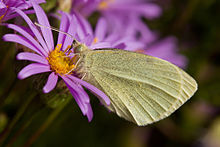Pieris rapae
| Small White | |
|---|---|

| |
| Scientific classification | |
| Kingdom: | |
| Phylum: | |
| Class: | |
| Order: | |
| Superfamily: | |
| (unranked): | |
| Family: | |
| Tribe: | |
| Genus: | |
| Species: | P. rapae
|
| Binomial name | |
| Pieris rapae (Linnaeus, 1758)
| |

The Small White (Pieris rapae) is a small- to medium-sized butterfly species of the Yellows-and-Whites family Pieridae. It is also commonly known as the Small Cabbage White. The names "Cabbage Butterfly" and "Cabbage White" can also refer to the Large White.
It is widespread across Europe, North Africa and Asia and has also been accidentally introduced to North America, Australia and New Zealand where they have become pests on cultivated cabbages and other mustard family crops.
In appearance it looks like a smaller version of the Large White. The upperside is creamy white with black tips to the forewings. Females also have two black spots in the center of the forewings. Its underwings are yellowish with black speckles. It is sometimes mistaken for a moth due to its plain-looking appearance. An adult's wingspan is roughly 32--47 mm (1.25--2 in).[1]
Life cycle
In Britain, it has two flight periods, April–May and July–August, but is continuously-brooded in North America, being one of the first butterflies to emerge from the chrysalis in spring, flying until hard freeze in the fall.
Its caterpillars can be a pest on cultivated cabbages, kale, radish, broccoli, and horseradish but it will readily lay eggs on wild members of the cabbage family such as Charlock Sinapis arvensis and Hedge mustard Sisybrium officinale. The eggs are laid singularly on foodplant leaves.
Traditionally known in the United States as the "Imported Cabbage Worm", now more commonly the "Cabbage White", the caterpillars are green and well camouflaged. Caterpillars rest on the undersides of the leaves, thus making them less visible to predators. Unlike the Large White, they are not distasteful to predators like birds. Like many other "White" butterflies, they hibernate as a pupa. It is also one of the most cold-hardy of the non-hibernating butterflies, occasionally seen emerging during mid-winter mild spells in cities as far north as Washington D.C.
Like its close relative the Large White this is a strong flyer and the British population is increased by continental immigrants in most years. Adults are diurnal and fly almost exclusively during mid-day, though it appears as if there is some activity in the later part of the night too, ceasing as dawn breaks.[2]
Gallery
-
Close-up of face
-
Caterpillar
-
Pupa, late stage
-
Pupa, ready to close
-
Copulation refusal action
-
Butterflies mating
-
Small White in Autumn
References
- ^ http://www.cbif.gc.ca/spp_pages/butterflies/species/CabbageWhite_e.php
- ^ * Fullard, James H. & Napoleone, Nadia (2001): Diel flight periodicity and the evolution of auditory defences in the Macrolepidoptera. Animal Behaviour 62(2): 349–368. doi:10.1006/anbe.2001.1753 PDF fulltext
- Asher, Jim et al.: The Millennium Atlas of Britain and Ireland. Oxford University Press.
- Evans, W.H. (1932): The Identification of Indian Butterflies (2nd Ed.). Bombay Natural History Society, Mumbai, India.
- Gaonkar, Harish (1996): "Butterflies of the Western Ghats, India (Including Sri Lanka) - A Biodiversity Assessment of a Threatened Mountain System." Journal of the Bombay Natural History Society.
- Gay, Thomas; Kehimkar, Isaac & Punetha, J.C. (1992): Common Butterflies of India. WWF-India and Oxford University Press, Mumbai, India.
- Kunte, Krushnamegh (2005): Butterflies of Peninsular India. Universities Press.
- "Pieris rapae". Integrated Taxonomic Information System. 6 February.
{{cite web}}: Check date values in:|date=and|year=/|date=mismatch (help) - Wynter-Blyth, M.A. (1957): Butterflies of the Indian Region. Bombay Natural History Society, Mumbai, India.
External links
- Pieris rapae on the UF / IFAS Featured Creatures Web site
- Cabbage White, Butterflies of Canada








